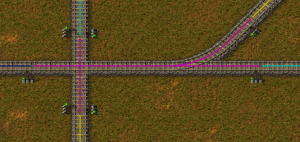Rail signal: Difference between revisions
(Fill 'stackupto') |
('stackupto' changed to 'stack_size') |
||
| Line 2: | Line 2: | ||
{{Machinery | {{Machinery | ||
|health =80 | |health =80 | ||
| | |stack_size =50 | ||
|input =time, 0.5 + electronic circuit + iron plate, 5 | |input =time, 0.5 + electronic circuit + iron plate, 5 | ||
|raw =time, 1.8 + iron plate, 6 + copper plate, 1.5 | |raw =time, 1.8 + iron plate, 6 + copper plate, 1.5 | ||
Revision as of 20:24, 25 August 2016
Rail signals are used for automated transportation on a railway network. With rail signals it is possible to use multiple trains on a single track.
Usage

- Place a Rail signal at the right side of a segment.
- Imagine this signal as a "cut" into the rails which splits the segments before and after this signal in two "blocks".
- If a train stands in any part of a block, the signal before this block is red.
- No other element can do this cut, which means, that all switches, crossings and so on are part of this block.
Pictures say more than thousands words: A guide on how to place signals.
The model railway understanding
Imagine that block signals works like in a model railway. The basics of this principle is as follows:
- The rails (left and right) can conduct electrical current (they are made out of steel).
- The train connects the left and right rail of a railway and works so as a conductor between the left and right rail.
- The signal puts a small current into one rail.
- If the train stands on the rail this voltage is also on the other rail. There is a connection between left and right rail.
- Can also be imagined that a small amount of electricity flows.
- The signal knows then: "Train on my block" and the signal goes red.
Now again to the definition of a block and segment:
- Segment: a single path of continuous track, a track between intersections or switches. You can see the number of the current segment when hovering the segment.
- Block: a set of segments (or one segment). Every connected segment belongs to one block, no matter if a train can drive on it or not, and no matter, if it can be driven only in one direction (for example a joining switch: the other segment of the switch belongs to the same block!). You can see the current block numbers of a rail piece in the info section.
Going back to the model railway example, this means:
- Every signal makes a "cut" into the rails.
- This cut splits one segment into two.
- And this stops also the electricity from flowing from block to block. In other words: Only segments inside a block are "connected". The electricity can flow into every segment of the block, but not in any other segment/block.
- This is also true, even if the train could not reach this segment, because it is in the wrong direction!
In other words: If there is no signal, then the segments are connected. Only signals split that connection!
Other mechanics
Yellow lamp
The signal looks into it's forward direction (the next block). If there is a connection (a train on it!) then it switches to red.
This is how it switches to yellow:
- The train needs some distance to stop. You can see this distance by going into the Debug mode and turn on "show_train_stop_point". You see: With increasing speed, this distance gets longer.
- All signals in the direction of the train path within this distance are switches to yellow (first come, first serve)
- Yellow signals "connect" the two sides of the track, exactly like, if there is a train on it.
- That switches all other incoming signals into that block to red...
Pass-by stations
- To enable more traffic on a long single-track, you need to create pass-by stations: Split the one-way track into a two-way track for the minimum length of the longest train. One way signals route the trains on one track per direction. For each track one-way-signals must be placed at the begin and end of each of the two pass-by-tracks.
- If you have enough pass-by-stations, you can connect them and have a two-way-track.
- Don't forget to leave a space of one track (~2 tiles) between parallel tracks. This will allow merging the tracks together if necessary.
Circuit control
The circuit network can be used to control switches, by disabling and enabling them. Trains will not pass through a disabled signal.
See also
External info
Some other games and real life have similar train mechanics to factorio, studying these may help when understanding trains.
- You can refer directly to the Block Signals in OpenTTD.
- A good explanation about what blocks are.
- And in Wikipedia.